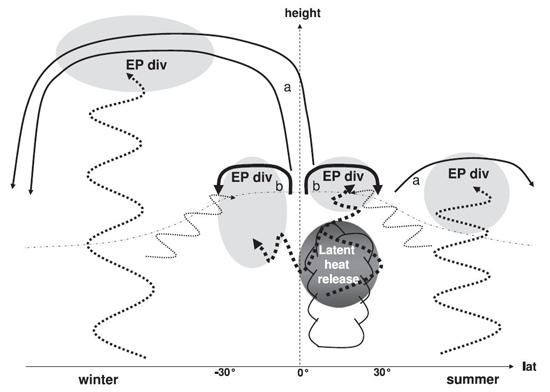How is the Brewer-Dobson circulation affected by climate change, and which processes are relevant?
Martin Dameris (PI), Andreas Engel, Ulrike Langematz, Hauke Schmidt, Gabriele Stiller
Phase I:
SHARP-BDC aims to identify and quantify dynamical, physical and chemical processes as well as feedback effects affecting the atmospheric residual circulation (Brewer-Dobson circulation, BDC), which is responsible for transport of stratospheric air masses from tropical to higher latitudes. Climate change is expected to modify the motion and mass exchange rates of air within the stratosphere and therefore the residence time and distribution of chemical substances. At the moment it is however unclear which atmospheric processes and feedbacks represent the major drivers for possible future changes. Previous analyses of long-term observations and results from numerical model simulations do not indicate a consistent picture. Multi-decadal transient simulations with General Circulation Models (GCMs) and Chemistry-Climate Models (CCMs) together with long-term observations (especially derived from satellite-, balloon- and ground-based instruments) will be used to investigate atmospheric processes affecting the BDC. In addition, supplementary numerical sensitivity studies with different models will be performed and interpreted to establish cause and effect relationships. It will be investigated how the relevant processes are going to change in a future climate, modifying stratospheric dynamics.

The Brewer-Dobson circulation leads to an upward transport of air in the tropics, followed by a poleward transport and sinking at higher latitudes in the winter stratosphere. A secondary branch exists in the (sub-)tropical lower stratosphere. Both cells are driven by dissipating waves.
Phase II:
This project aims to identify and quantify dynamical, physical and chemical processes as well as feedback effects affecting the stratospheric circulation (Brewer-Dobson circulation, BDC), which is responsible for transport of stratospheric air masses from tropical to higher latitudes. Climate change is expected to modify the motion and mass exchange rates of air within the stratosphere and therefore the residence time and distribution of chemical substances. Although substantial progress has been achieved in recent years regarding understanding relevant processes affecting the Brewer-Dobson circulation, there are still open issues about atmospheric processes and feedbacks impacting the long-term changes of the BDC. Common analyses of observations and results from numerical model simulations still do not indicate a consistent picture. Multi-decadal transient simulations with Atmospheric General Circulation Models, climate models and Chemistry-Climate Models together with assembled, consistent long-term observations (especially derived from space-borne-, balloon-, aircraft- and ground-based instruments) will be further used to investigate atmospheric processes affecting the BDC. Supplementary numerical sensitivity studies with the different models will be performed and interpreted allowing a process-oriented evaluation of dynamical and chemical processes relevant for the BDC and its possible future changes. It will be investigated how the relevant processes are going to alter in a changing climate, modifying stratospheric dynamics.



